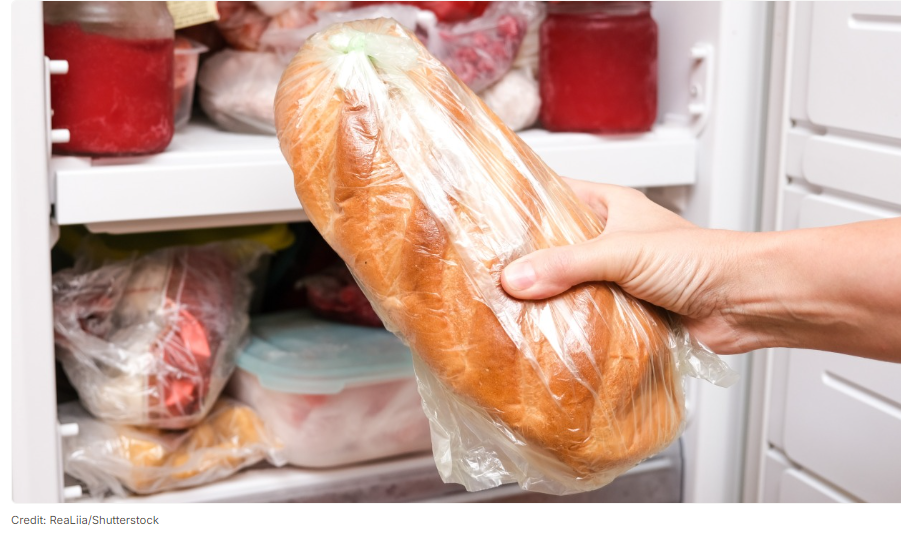3 min read//
Bread can be overtaken by moldy bits and staleness quickly, but storing it properly can largely prevent those problems altogether. I’m not talking about siloing away your loaf in one of those aesthetically cute wooden bread boxes. While those create helpful barriers if, say, you have a carb-loving cat like I do, they don’t do much to prevent mold colonies from forming. Countertop bread boxes are quaint, but truly, the best bread box is your freezer.
Keep it in shape
Fortunately, many foods keep well in the freezer. Unfortunately, that makes my freezer a bit like a clown car—there’s a befuddling and slightly alarming amount of stuff crammed in there, and yet there’s always room for more. In itself, that’s a good thing: the freezer holds its temperature and conserves energy, but it can spell trouble for the delicate shape of soft, fluffy bread.
Since bread is made of many small, beautifully arranged air pockets, the shape is easily crushed. If you cram it in with the rest of the clowns, it’ll freeze solid in that smashed shape and stay that way even after thawing. For the bread’s sake, freeze it first, uncrushed, for 30 minutes before stashing. Put soft breads, like rolls, brioche buns, or biscuits on a sheet tray with nothing stacked on top of them. Once they’re solid, you can pack them into any place they’ll fit. Or even better…
Bread homes to consider:
-
Tafura Bread Container with Airtight Lid
-
Lock & Lock Airtight Food Storage Container
-
Komax Extra-large Food Storage Bin with Lid
Make a home for your bread
Anyone who likes to have a slice or two on a daily basis has graduated to Bread Spot status. You should make a defined Bread Spot in your freezer that only houses your precious loaves. While I don’t think the traditional, non-airtight countertop bread box is helpful, a freezer-safe container to sequester your breads from the other stuff works well. Just make sure you don’t forget about it in the back of the freezer.
For irregularly shaped artisan breads, like boules or batards, wrap tightly and place them in a wide plastic tub-like container that fits on the top shelf of the freezer. Something like this Komax storage bin would work well. Is it marketed as a freezer-safe pet food container? Yes, but that doesn’t mean you have to use it for pet food. For a household that fiends for sliced sandwich bread, you might consider a long tubular container constructed especially for the job.
Prevent freezer burn
To be clear, freezers are a boon to at-home food preservation and effectively reduce waste, but there is a trade-off to the wondrous machine: freezer burn. While your food is safe from humidity-induced mold growth, freezer burn can happen to anything you put in there as long as it contains moisture, including bread.
You’ve probably seen it before. You discover a piece of chicken or steak that was lingering in the freezer, only to unwrap it and find an icy piece of foil and discolored, dried out meat inside. With bread, the slice looks pale and dry, while ice crystals have collected on the surface or inside the storage bag. This is the visual result of sublimation, when ice turns directly into water vapor. The freezer keeps a dry, cold environment and, as BBC Science Focus explains, “Ice sublimates in an effort to equilibrate with the [vapor] pressure of air in the freezer.”
Technically it’s safe to eat freezer burnt food, but the taste and texture can suffer, and to me that defeats the whole point of eating. To prevent freezer burn, minimize the food’s exposure to the dry, circulating air of the freezer. Foil wrappings or thin stretch plastics, the bread’s bag, and some zip top bags are porous or tear easily. Basically, they’re not actually airtight.
If freezer burn seems to happen a lot to your food, invest in secure airtight containers, bags that are freezer-friendly (usually thicker than others), or try doubling up. It helps to eliminate air inside the container when possible too. While this isn’t feasible with rigid materials, you can do it with freezer bags. Keep sliced sandwich bread in the same bag it came in, squish all the air out (gently), tie it up, and slide it into one of those close-fitting storage tubes. This can be especially helpful if you’re likely to keep breads hanging around for months at a time. (It’s me. Guilty.) Once your bread is safely tucked away in its new frozen kingdom, you’ll be able to defrost and toast your carbs at will without worrying about moldy slices or stale biscuits ever again.











